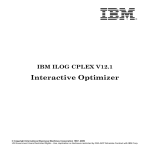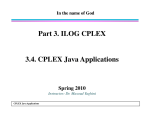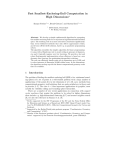Download Getting Started with CPLEX for MATLAB
Transcript
IBM ILOG CPLEX Optimization Studio
Getting Started with CPLEX for MATLAB
Version 12 Release 4
Copyright notice
Describes general use restrictions and trademarks related to this document and the software described in this document.
© Copyright IBM Corp. 1987, 2011
US Government Users Restricted Rights - Use, duplication or disclosure restricted by GSA ADP Schedule Contract with
IBM Corp.
Trademarks
IBM, the IBM logo, ibm.com, WebSphere, and ILOG are trademarks or registered trademarks of International Business
Machines Corp., in many jurisdictions worldwide. Other product and service names might be trademarks of IBM or other
companies. A current list of IBM trademarks is available on the Web at Copyright and trademark information
(http://www.ibm.com/legal/copytrade.shtml).
Adobe, the Adobe logo, PostScript, and the PostScript logo are either registered trademarks or trademarks of Adobe
Systems Incorporated in the United States, and/or other countries.
Linux is a registered trademark of Linus Torvalds in the United States, other countries, or both.
UNIX is a registered trademark of The Open Group in the United States and other countries.
Microsoft, Windows, Windows NT, and the Windows logo are trademarks of Microsoft Corporation in the United States,
other countries, or both.
Java and all Java-based trademarks and logos are trademarks or registered trademarks of Oracle and/or its affiliates.
Other company, product, or service names may be trademarks or service marks of others.
Further acknowledgements
IBM ILOG CPLEX states these additional registered trademarks and acknowledgements.
Additional registered trademarks
Python is a registered trademark of the Python Software Foundation.
MATLAB is a registered trademark of The MathWorks, Inc.
Acknowledgement of use: dtoa routine of the gdtoa package
IBM ILOG CPLEX acknowledges use of the dtoa routine of the gdtoa package, available at
http://www.netlib.org/fp/.
The author of this software is David M. Gay.
All Rights Reserved.
Copyright (C) 1998, 1999 by Lucent Technologies
Permission to use, copy, modify, and distribute this software and its documentation for any purpose and without
fee is hereby granted, provided that the above copyright notice appears in all copies and that both that the
copyright notice and this permission notice and warranty disclaimer appear in supporting documentation, and that
the name of Lucent or any of its entities not be used in advertising or publicity pertaining to distribution of the
software without specific, written prior permission.
LUCENT DISCLAIMS ALL WARRANTIES WITH REGARD TO THIS SOFTWARE, INCLUDING ALL IMPLIED
WARRANTIES OF MERCHANTABILITY AND FITNESS. IN NO EVENT SHALL LUCENT OR ANY OF ITS
ENTITIES BE LIABLE FOR ANY SPECIAL, INDIRECT OR CONSEQUENTIAL DAMAGES OR ANY DAMAGES
WHATSOEVER RESULTING FROM LOSS OF USE, DATA OR PROFITS, WHETHER IN AN ACTION OF
CONTRACT, NEGLIGENCE OR OTHER TORTIOUS ACTION, ARISING OUT OF OR IN CONNECTION WITH
THE USE OR PERFORMANCE OF THIS SOFTWARE.
(end of acknowledgement of use of dtoa routine of the gdtoa package)
© Copyright IBM Corporation 1987, 2011.
US Government Users Restricted Rights – Use, duplication or disclosure restricted by GSA ADP Schedule Contract
with IBM Corp.
Contents
Chapter 1. Introduction . . . . . . . . 1
Chapter 5. Overview of the CPLEX for
MATLAB APIs . . . . . . . . . . . . 9
Chapter 2. Installation of CPLEX for
MATLAB . . . . . . . . . . . . . . 3
CPLEX for MATLAB Toolbox . . . . . . . . . 9
Cplex Class API . . . . . . . . . . . . . 11
Chapter 3. Integration with MATLAB
Chapter 6. Programming tips . . . . . 15
. . 5
Chapter 4. Using CPLEX for MATLAB . . 7
© Copyright IBM Corp. 1987, 2011
iii
iv
Getting Started with CPLEX for MATLAB
Chapter 1. Introduction
An overview of CPLEX® for MATLAB.
CPLEX for MATLAB is an extension to IBM® ILOG® CPLEX Optimizers that allows
a user to define optimization problems and solve them within MATLAB. Thus a
student or practitioner who is using MATLAB can easily solve optimization
problems within that framework.
© Copyright IBM Corp. 1987, 2011
1
2
Getting Started with CPLEX for MATLAB
Chapter 2. Installation of CPLEX for MATLAB
Install and set up IBM ILOG CPLEX Optimization Studio before using the CPLEX
connector for MATLAB.
If you have not yet set up CPLEX, first follow those procedures for installation
before you begin using the CPLEX connector for MATLAB.
Instructions for installation are available at the IBM Support Portal under the topic
Choose your task: Installation.
© Copyright IBM Corp. 1987, 2011
3
4
Getting Started with CPLEX for MATLAB
Chapter 3. Integration with MATLAB
The menu items and windows used to solve optimization models are described.
CPLEX for MATLAB should be integrated into your MATLAB environment in
order for you to take full advantage of its features.
When you have installed CPLEX for MATLAB and set the paths as described in
the readme.html file, a new item is added to the Toolboxes section of the MATLAB
Start Button. You can use the items on this menu to find more help about using
CPLEX.
In addition, the online manuals for CPLEX for MATLAB have been added to the
MATLAB Product Help, available from the drop down menu Help > Product
Help.
Within the MATLAB Command Window, inline help is available for the CPLEX
classes and functions. For example typing 'help cplexlp' will display information
about the function cplexlp.
© Copyright IBM Corp. 1987, 2011
5
6
Getting Started with CPLEX for MATLAB
Chapter 4. Using CPLEX for MATLAB
Presents an overview of how to solve an optimization problem.
IBM ILOG CPLEX Optimizers provides a tool for solving optimization, or
mathematical programming, problems.
The most basic mathematical programming problem is commonly referred to as
Linear Programming (LP) problem. The basic form of an LP problem is:
Maximize (or Minimize)
subject to
f*x
Aeq*x = beq
with these bounds
Aineq*x <= bineq
l <= x <= u
where Aeq and Aineq are matrices, f, beq, bineq, l and u are vectors such that the
upper bounds u(i) and lower bounds l(i) may be positive infinity, negative
infinity, or any real number. Both sparse and dense format can be used in all places
where matrices/vectors are used.
The elements of data you provide as input for this LP problem are:
Objective function coefficients
Constraint coefficients
f
Aeq
Aineq
Righthand sides
beq
bineq
Upper and lower bounds
u
l
The optimal solution that CPLEX computes and returns is:
Variables
x
CPLEX for MATLAB can also solve several extensions to LP:
v Quadratic Programming (QP) problems, where the LP objective function is
expanded to include quadratic terms.
v Quadratically Constrained Programming (QCP) problems that include quadratic
terms among the constraints. In fact, CPLEX can solve Second Order Cone
Programming (SOCP) problems.
v Mixed Integer Programming (MIP) problems, where any or all of the LP, QP, or
QCP variables are further restricted to take integer values in the optimal solution
and where MIP itself is extended to include constructs like Special Ordered Sets
(SOS), semi-continuous variables, and indicator variables.
© Copyright IBM Corp. 1987, 2011
7
v Least Squares (LSQ) problems, where the objective is to minimize a norm. The
problem can be constrained linearly or quadratically, and the variables may be
restricted to take integer values in the solution.
The standard MATLAB vector and matrix format is used for the elements of data
that you need to provide. For example, the CPLEX for MATLAB Toolbox function
cplexlp solves the problem specified by
min
st.
f*x
Aineq*x <= bineq
Aeq*x
= beq
lb <= x <= ub
where f, bineq, beq, lb, and ub are MATLAB vectors, and Aineq and Aeq are
MATLAB matrices.
The vector x returned by the function call
x = cplexlp(f,Aineq,beq,Aeq,beq,lb,ub)
contains the optimal solution to the specified linear programming problem.
Provided in CPLEX for MATLAB is both a toolbox of functions and a class API.
The toolbox contains functions for solving optimization problems, where the input
matrices are provided to the function and results returned. With the class API,
objects can be created, and those objects carry a state.
The benefits of using the Cplex class API include the ability to:
v build up a model by manipulating a Cplex object.
v use computation methods such as Cplex.solve() and Cplex.refineConflict()
that modify the object so results can be queried as needed.
v perform restarts after manipulation.
v attach an output parser, a GUI with stop buttons, and other controls.
8
Getting Started with CPLEX for MATLAB
Chapter 5. Overview of the CPLEX for MATLAB APIs
CPLEX for MATLAB provides two APIs for solving mathematical programming
problems, the toolbox functions and the Cplex class.
CPLEX for MATLAB Toolbox
The toolbox provides functions for solving a variety of mathematical programming
problems.
The CPLEX for MATLAB Toolbox provides functions for solving a variety of
mathematical programming problems. The toolbox functions are designed to take a
model description as input and produce a solution as output.
For example:
x = cplexlp(f,Aineq,bineq,Aeq,beq,lb,ub)
finds the minimum of a linear programming problem specified by
min
st.
f*x
Aineq*x <= bineq
Aeq*x
= beq
lb <= x <= ub
The toolbox provides the functions cplexlp, cplexqp and cplexbilp to solve linear
programming problems (LP), quadratic programming problems (QP) and binary
integer programming problems (BILP).
The toolbox provides functions that support the solution of the basic problem
types handled by CPLEX are:
v cplexlp for linear programming problems (LP),
v cplexqp for quadratic programming problems (QP) and
v cplexbilp for binary integer programming problems (BILP).
Functions that support the solution of additional problem types handled by CPLEX
are provided. These functions are:
v cplexqcp for quadratically constrained programming problems (QCP),
v cplexmilp for mixed integer linear programming problems (MIP),
v cplexmiqp for mixed integer quadratic programming problems (MIQP) and
v cplexmiqcp for mixed integer quadratically constrained mixed integer
programming problems (MIQCP).
The solution of least square problems is supported through the functions:
v cplexlsqlin for linearly constrained least squares problems,
v cplexlsqmilp for linearly constrained mixed integer least squares problems,
v
v
cplexlsqbilp for linearly constrained binary integer least squares problems,
cplexlsqmiqcp for quadratically constrained mixed integer least squares
problems,
v cplexlsqqcp for quadratically constrained programming problems,
v cplexlsqnonneglin for nonnegative least squares problems,
© Copyright IBM Corp. 1987, 2011
9
v cplexlsqnonnegmilp for nonnegative mixed integer least squares problems,
v cplexlsqnonnegmiqcp for nonnegative quadratically constrained mixed integer
least squares problems and
v cplexlsqnonnegqcp for nonnegative quadratically constrained programming
problems.
The advantage of the toolbox design is that you can reuse your code where you
had used MATLAB Optimization Toolbox functions to solve linear programming,
quadratic programming, binary integer programming, linearly constrained least
squares, and nonnegative least squares problems.
Setting and querying parameters in the CPLEX for MATLAB
Toolbox
Options, also called parameters, can be set to control the solution of problems. The
toolbox provides two types of options input. One type corresponds to the
MATLAB Optimization Toolbox options, and the other type is the CPLEX
parameters. You can use either or both of these types of options. If you use both,
the CPLEX parameters will override the MATLAB options.
The toolbox options are listed in the following table.
Options corresponding to the MATLAB Optimization Toolbox
Diagnostics
Display
MaxIter
Simplex
BranchStrategy
MaxNodes
MaxTime
NodeDisplayInterval
NodeSearchStrategy
TolFun
TolXInteger
TolRLPFun
'on' | {'off'}
'off' | 'iter' | 'final' | 'notify'
refer to
cplex.Param.simplex.limits.iterations
refer to cplex.Param.lpmethod
refer to cplex.Param.qpmethod
refer to
cplex.Param.mip.strategy.startalgorithm
refer to
cplex.Param.mip.strategy.variableselect
refer to cplex.Param.mip.limits.nodes
refer to cplex.Param.timelimit
refer to cplex.Param.mip.interval
refer to
cplex.Param.mip.strategy.nodeselect
refer to
cplex.Param.simplex.tolerances.optimality
refer to
cplex.Param.mip.tolerances.integrality
refer to
cplex.Param.simplex.tolerances.optimality
.
These options can be set using the toolbox function optimset. For example, the
following code turns on the optimizer output and sets a node limit of 400,
options = cplexoptimset(’Diagnostics’, ’on’, ’MaxNodes’, 400);
Alternatively, these options can be set directly on the fields of the structure. For
example, the following code has the same result as the previous one.
10
Getting Started with CPLEX for MATLAB
options = cplexoptimset;
options.Diagnostics = ’on’;
options.MaxNodes = 400;
The current and default values of the options can be queried with the function
optimget.
If you need to use CPLEX parameters that do not correspond to the options in the
MATLAB Optimization Toolbox, you can create a structure which contains all of
the CPLEX parameters. For example, to set a node limit of 400 and instruct CPLEX
to use traditional branch and cut style search:
opt = cplexoptimset(’cplex’);
opt.mip.limits.nodes=400;
opt.mip.strategy.search=1;
Tip:
If you are already familiar with the names of parameters in the Interactive
Optimizer, then you quickly recognize names of parameters in CPLEX for
MATLAB. For example, the command “set mip limits nodes 1” in the Interactive
Optimizer corresponds to “opt.mip.limits.nodes = 1;” in the CPLEX for MATLAB
Toolbox where opt was created with the line “opt = optimset(’cplex’);”
To assist in setting parameters, auto-completion of parameter names is available in
the MATLAB environment.
Cplex Class API
Describes the Cplex class
While the CPLEX for MATLAB Toolbox functions provide the ability to solve a
multitude of mathematical programming problems, the toolbox design does not
support restart. To enable users to use decomposition algorithms, the Cplex Class
API is also provided in CPLEX for MATLAB.
The Cplex class stores the model and provides methods for the solution, analysis,
manipulation and reading/writing of the model file. All of the data associated with
the problem is stored in the properties of a Cplex object. These class properties are
standard MATLAB data structures and can be manipulated directly within
MATLAB. However, modifying the problem using methods provided in the Cplex
class enforces consistency, such as ensuring that vectors are of the proper length.
The documentation of the Cplex class provides an introduction of properties and
methods of the Cplex class in more detail.
The properties of the Cplex class include:
Cplex.Model
Cplex.Solution
Cplex.Param
Cplex.Start
Cplex.MipStart
Cplex.InfoCallback
Cplex.Conflict
Cplex.Order
stores the data of the model
stores the solution of the model
stores the parameters (options) of the model
stores the start of the LP model
stores the start of the MIP model
pointer to an informational callback
stores the conflict information of a conflicted
model
stores the priority order information
Chapter 5. Overview of the CPLEX for MATLAB APIs
11
Cplex.DisplayFunc
pointer to a function which provides control
of display of output
The following informative methods are provided:
Cplex.getVersion
Cplex.getProbType
returns the CPLEX version
returns the problem type of the model
The following methods are provided for reading from and writing to files:
Cplex.readModel
Cplex.writeModel
Cplex.readBasis
Cplex.writeBasis
Cplex.readMipStart
Cplex.writeMipStart
Cplex.readParam
Cplex.writeParam
Cplex.writeConflict
The following methods are provided to solve and analyze the model, solution and
mipstart:
Cplex.solve
Cplex.populate
Cplex.feasOpt
Cplex.refineConflict
Cplex.refineMipStartConflict
Cplex.terminate
The following methods are provided to solve, set and query parameters:
Cplex.tuneParam
Cplex.setDefault
Cplex.getChgParam
Although a model can be modified by manipulating the MATLAB data structures
directly, the following functions are provided to make modifications easier:
Cplex.addCols
Cplex.addRows
Cplex.delCols
Cplex.delRows
Cplex.addSOSs
Cplex.addQCs
Cplex.addIndicators
Setting and querying parameters in the CPLEX Class API
To set parameters using the CPLEX Class API, you set the current values of the
fields in the Param structure property of the Cplex class. For example, to set a node
limit of 400 and instruct CPLEX to use traditional branch and cut style search:
12
Getting Started with CPLEX for MATLAB
cpx.Param.mip.limits.nodes.Cur=400;
cpx.Param.mip.strategy.search.Cur=1;
Tip:
If you are already familiar with the names of parameters in the Interactive
Optimizer, then you quickly recognize names of parameters in CPLEX for
MATLAB. For example, the command “set mip limits nodes 1” in the Interactive
Optimizer corresponds to “cpx.Param.mip.limits.nodes.Cur = 1;” in the CPLEX
Class API where cpx is an instance of the Cplex class.
To assist in setting parameters, auto-completion of parameter names is available in
the MATLAB environment.
Chapter 5. Overview of the CPLEX for MATLAB APIs
13
14
Getting Started with CPLEX for MATLAB
Chapter 6. Programming tips
As you model and solve mathematical programming problems, you may find it
useful to refer to the documentation to find answers to your questions.
As you model and solve mathematical programming problems with CPLEX for
MATLAB, you may find it useful to refer to the documentation to find answers to
your questions.
Some common questions are answered in this documentation as well as the CPLEX
User's Manual available in your CPLEX distribution.
v How do I use the MATLAB sparse matrix format with the CPLEX for
MATLAB functions and classes?
Either sparse or dense format can be used in the connector in all places where
double matrices and vectors are accepted as arguments.
v How do I understand and deal with my infeasible (or unbounded) model?
The section Infeasibility and unboundedness of the CPLEX User's Manual
documents tools to help you analyze the source of the infeasibility in a model:
the preprocessing reduction parameter for distinguishing infeasibility from
unboundedness, the conflict refiner for detecting minimal sets of mutually
contradictory bounds and constraints, and FeasOpt for repairing infeasibilities.
v How do I obtain a pool of multiple solutions?
The section Discrete optimization > Solution pool: generating and keeping multiple
solutions of the CPLEX User's Manual introduces the solution pool for storing
multiple solutions to a mixed integer programming problem (MIP) and explains
techniques for generating and managing those solutions.
v How do I get this difficult model to solve?
The section Programming considerations > Tuning tool of the User's Manual
documents the tuning tool, a utility to aid you in improving the performance of
your optimization applications, analyzes a model or a group of models and
suggests a suite of parameter settings for you to use that provide better
performance than the default parameter settings for your model or group of
models.
v How do I invoke parallel threads to solve my model faster?
The section Advanced programming techniques > Parallel optimizers of the CPLEX
User's Manual documents the CPLEX parallel optimizers.
v How do I set algorithm control parameters?
The CPLEX Parameters Reference Manual lists all of the parameters and explains
their settings. To learn about setting parameters when using the toolbox
functions, see the function cplexoptimset. For information about setting
parameters while using the Cplex class API, see Cplex.Param.
v How do I check the consistency of my data?
There is a consistency check which can be controlled by the datacheck
parameter. The default value of datacheck is off, which can improve the
performance in the case of valid model data. If the datacheck is on, then a
detailed error message will be displayed in the case of invalid data. For
information about setting parameters, see Cplex.Param and cplexoptimset.
© Copyright IBM Corp. 1987, 2011
15
Printed in USA









































